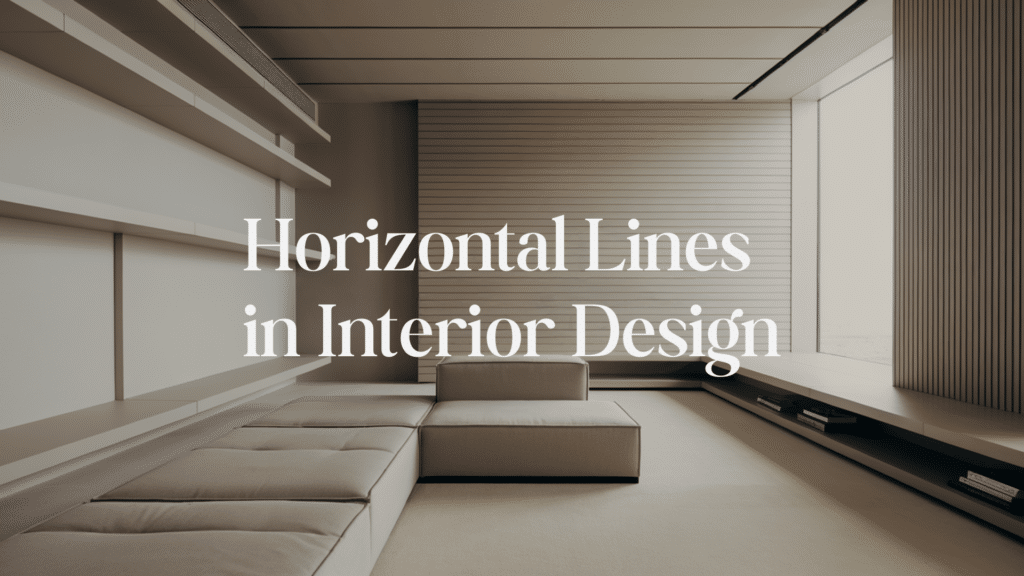Have you ever walked into a room and felt calm without knowing why? Often, it has to do with how lines are used in the space. In interior design, horizontal lines are straight lines that move side to side across a surface, running parallel to the floor.
These lines help shape how we see and feel a room. They can make walls look longer, furniture appear wider, and small spaces feel more open. You’ll often find horizontal lines in things like long shelves, low benches, wall paneling, and even tile layouts.
Designers use horizontal lines to create a sense of calm and stability in a space. They lead the eye from one end of the room to the other, helping to create a smooth visual flow.
In this blog, you’ll learn how horizontal lines affect space, where to use them, how to balance them with other elements, and what to avoid for the best results.
Visual Effects of Horizontal Lines in a Room
Horizontal lines can change the way a room looks and feels. They guide the eyes, shape the space, and help create a clear and peaceful layout. Each effect depends on how and where you use the lines.
1. Make a Room Feel Wider or Longer
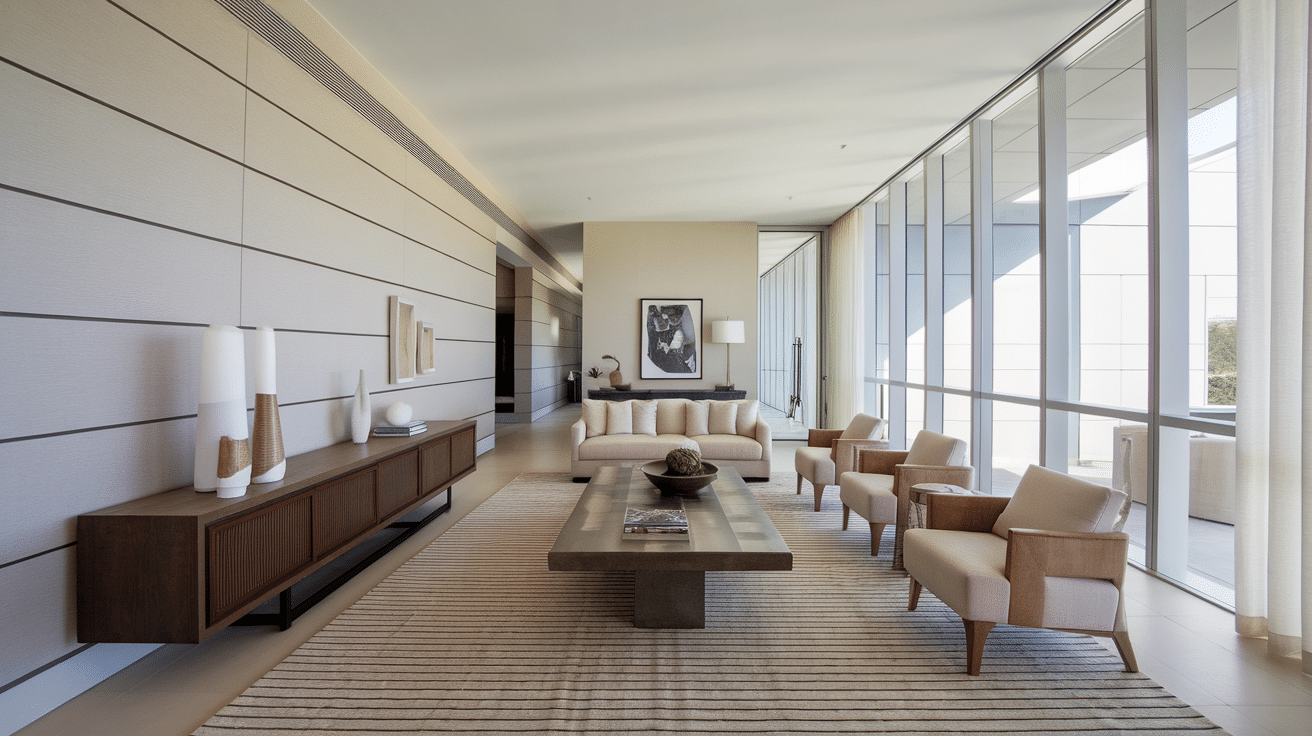
Horizontal lines stretch across a space from side to side. This movement makes walls seem longer and rooms appear wider. It’s a simple trick to open up tight spaces.
This effect can be used in small rooms or narrow hallways. A low, wide shelf or horizontal wall trim works well. These lines pull the eyes outward, helping the space feel larger.
Furniture with long, straight shapes adds to the effect. A long sofa or console table can visually extend the room, and even a striped rug can do the same job.
This is helpful in homes with limited space. Instead of changing the layout, you change how it feels. Horizontal lines make a small area feel more open without adding square footage.
2. Create a Calm and Grounded Feeling
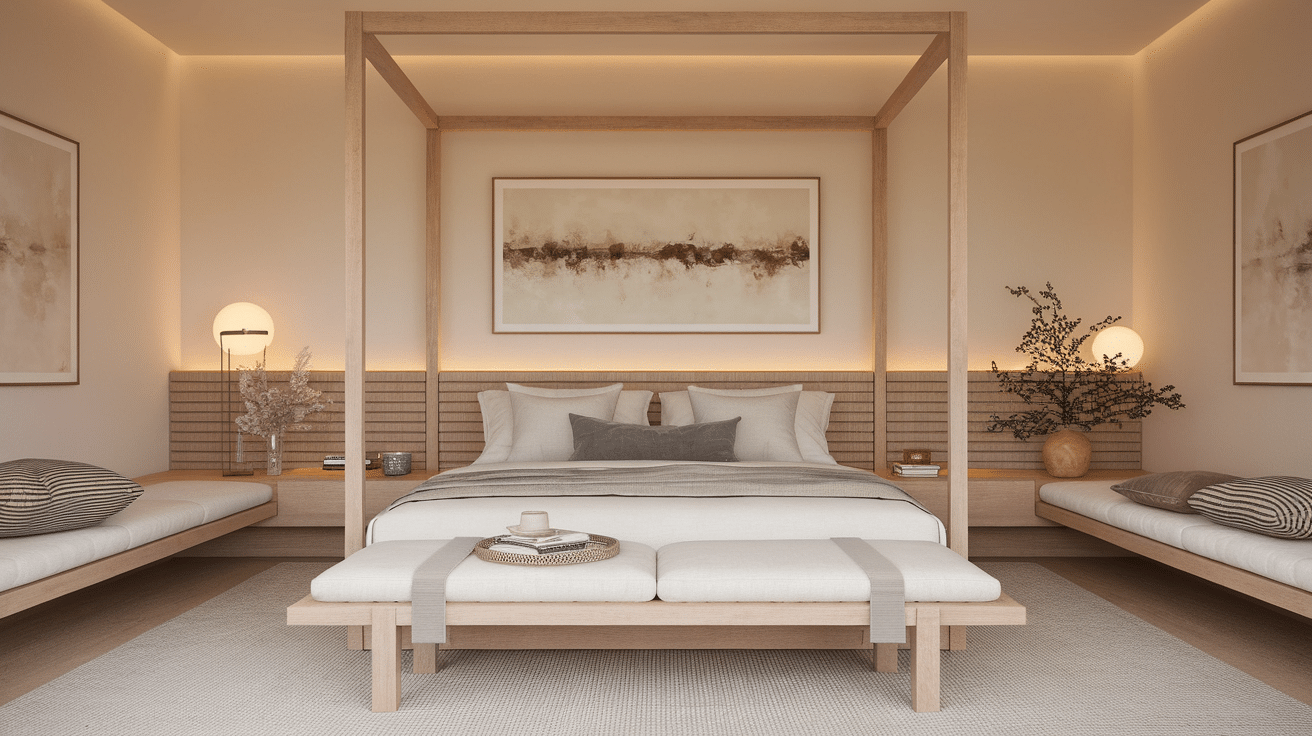
Horizontal lines give a room a calm, steady look. They don’t rush the eyes upward or downward—they keep the focus steady, adding a quiet, restful feeling to the space.
Using these lines helps people feel more at ease, which is a big plus in rooms like bedrooms or reading corners. The lines help slow things down.
You can add this effect with low furniture or even a long bench. Horizontal artwork also works well. The goal is to keep the eyes level and the mood calm.
This setup is great for spaces meant for rest. It adds order and comfort without drawing too much attention. The room feels settled, and so do the people in it.
3. Lead the Eye Across the Room
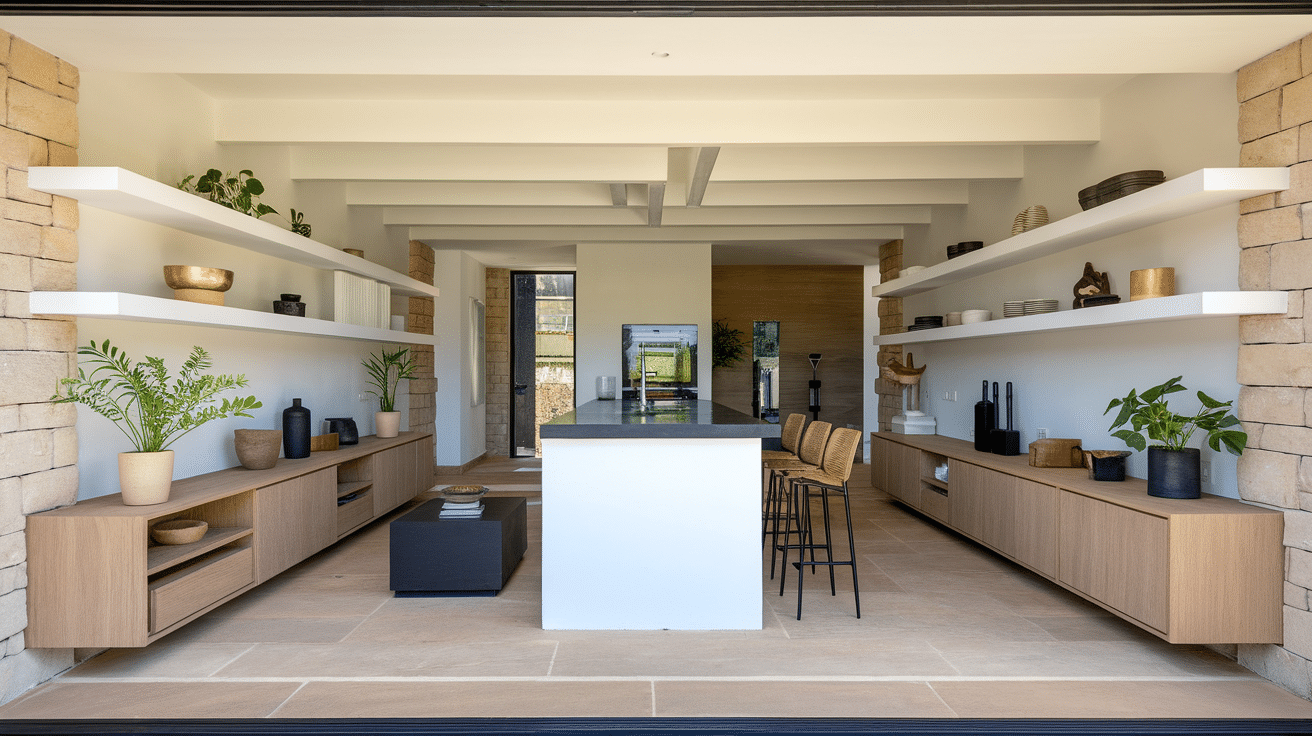
Horizontal lines act as guides for the eye. They move your gaze from one side of the room to the other, adding flow and direction to the space.
Shelves, long wall panels, and sideboards can do this well. They help connect one part of the room to another, making the layout feel more complete.
In open floor plans, horizontal lines tie spaces together. You can lead the eye from the kitchen to the living area. It feels more natural and easy to follow.
This trick is helpful when you want to highlight certain areas. A long line can point toward a window, a piece of art, or a seating area. It adds quiet focus without being too strong.
4. Add Structure Without Making the Space Feel Heavy
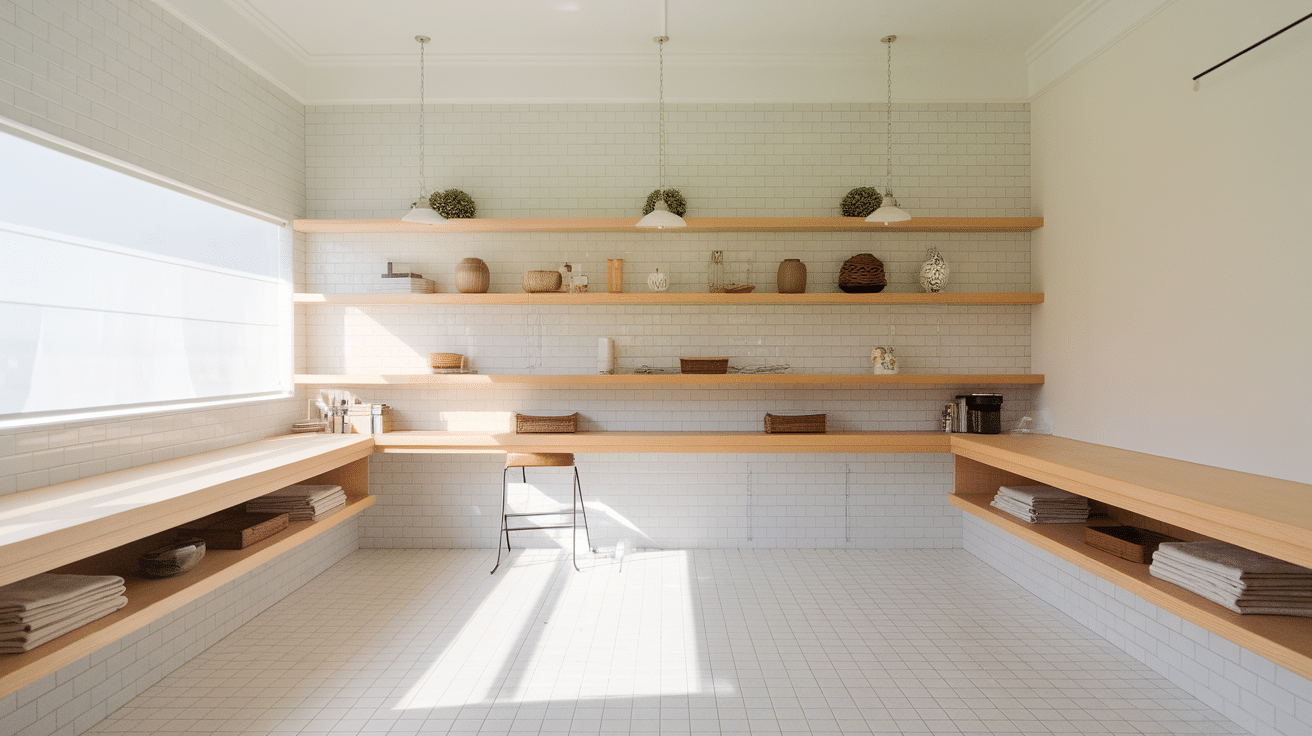
Horizontal lines bring order to a room without taking over. They help shape the space by creating a base for the eyes to rest on, keeping it from feeling too empty or too full.
You can use low shelves, trim, or tile lines for this. These elements give shape and support to the room’s layout, adding design without adding bulk.
This is useful when you want a clean and light look. The lines give just enough form without adding weight, so the space still feels open.
Structure matters, but it doesn’t need to be bold or too strong. Horizontal lines offer quiet control. They help you build a space that feels clear and well put together.
Common Areas to Use Horizontal Lines in Your Home
Horizontal lines can work in every part of your home. They help shape each room in a way that feels open and balanced. With simple choices in furniture and layout, you can add these lines without much effort.
1. Entryways – Benches and Slim Tables
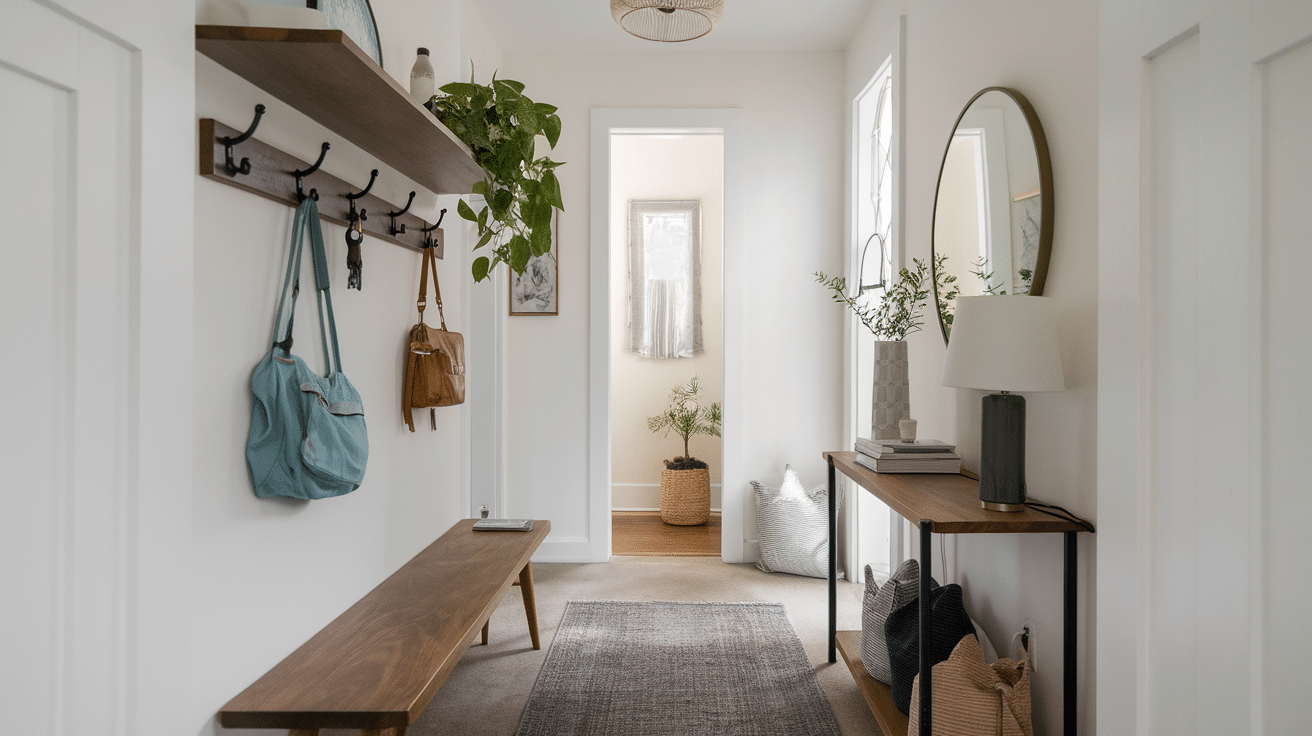
Entryways are a great place to use horizontal lines. A slim bench or a narrow console table adds a long, low line that grounds the space. It also gives you a spot for shoes, bags, or keys.
These pieces guide the eye from one side of the hallway to the other. They also help the area feel wider and more open. This is especially helpful in small or narrow entryways.
You can also add a row of hooks or a low shelf above the bench. This adds more function and keeps the line going, making the space feel both useful and neat.
Keep it simple to avoid crowding the area. A clean bench and one or two wall accents are enough. The goal is to add shape without adding clutter.
2. Living Rooms – Long Sofas and Low Furniture
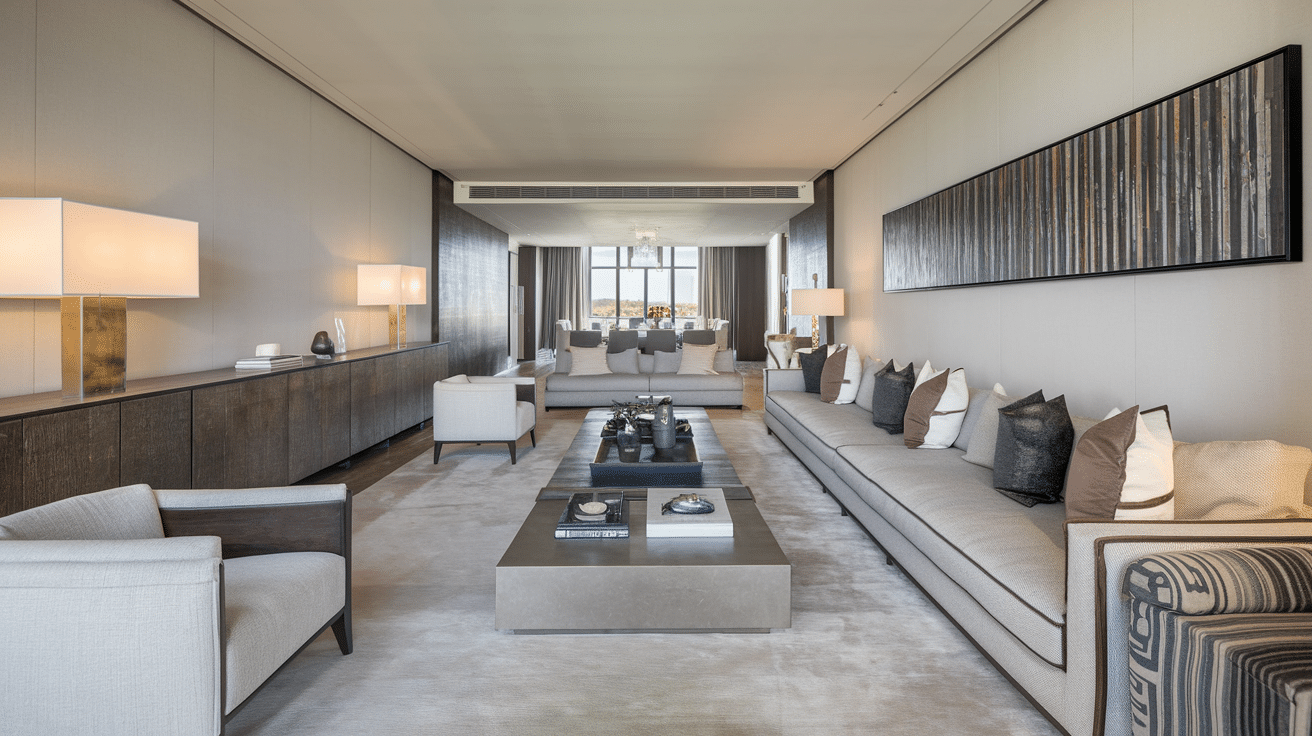
In the living room, long sofas naturally create horizontal lines. These pieces sit low to the ground and stretch across the space, making the room feel wider and more relaxed.
TV stands, coffee tables, and sideboards also add long lines. These items help anchor the space and guide the eye across the room, tying the whole area together.
Horizontal artwork can boost the effect. A wide painting or shelf above the sofa adds to the flow, making the room feel steady and complete.
Don’t fill the room with too many shapes. A few strong horizontal pieces are enough. Keep it open so the lines can do their job.
3. Bedrooms – Headboards and Bed Frames
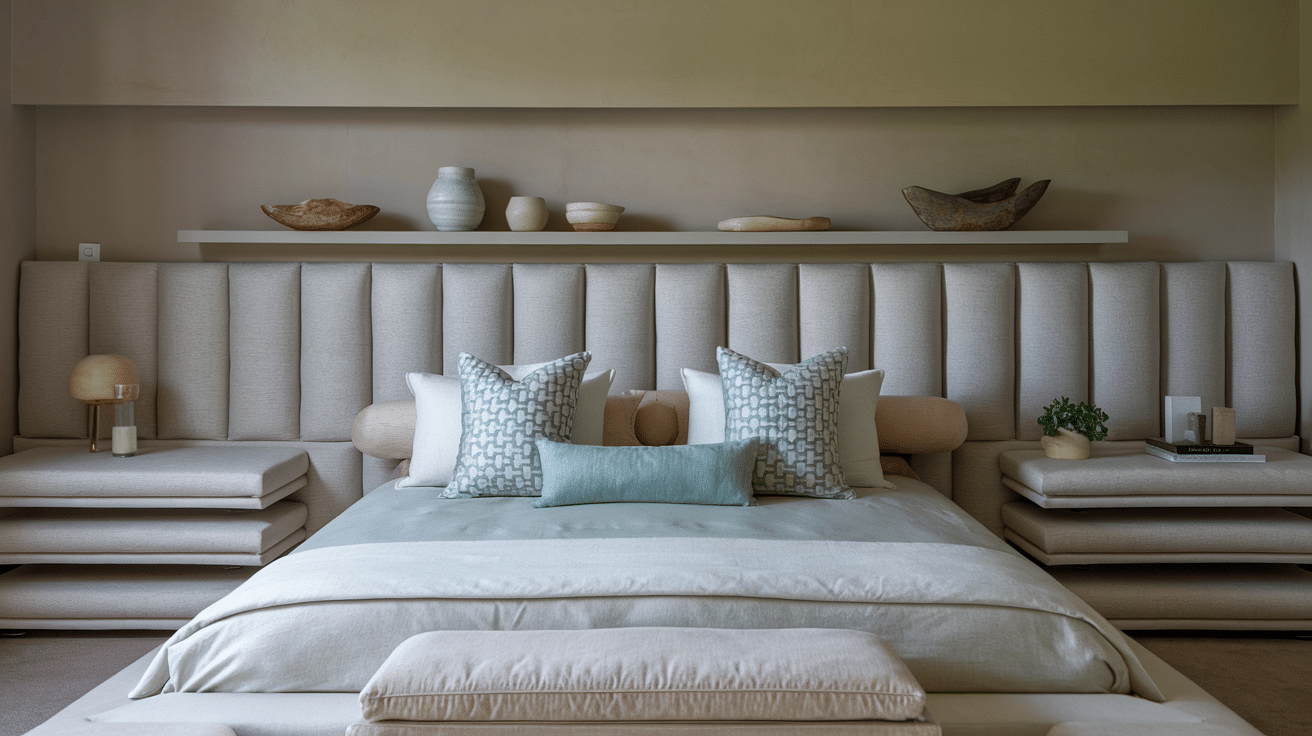
In bedrooms, horizontal lines can create a peaceful mood. A wide headboard or low bed frame helps bring a sense of calm. These pieces shape the space and add quiet balance.
Nightstands that line up with the bed keep the flow going. You can also use long shelves or low dressers. These details add to the feeling of rest.
Use soft colors to keep the lines gentle. This keeps the space light and helps you relax. It’s perfect for winding down at the end of the day.
Avoid bulky furniture that blocks the effect. Clean lines and simple shapes work best. Let the room breathe and feel easy to use.
4. Kitchens and Bathrooms – Cabinets and Shelving
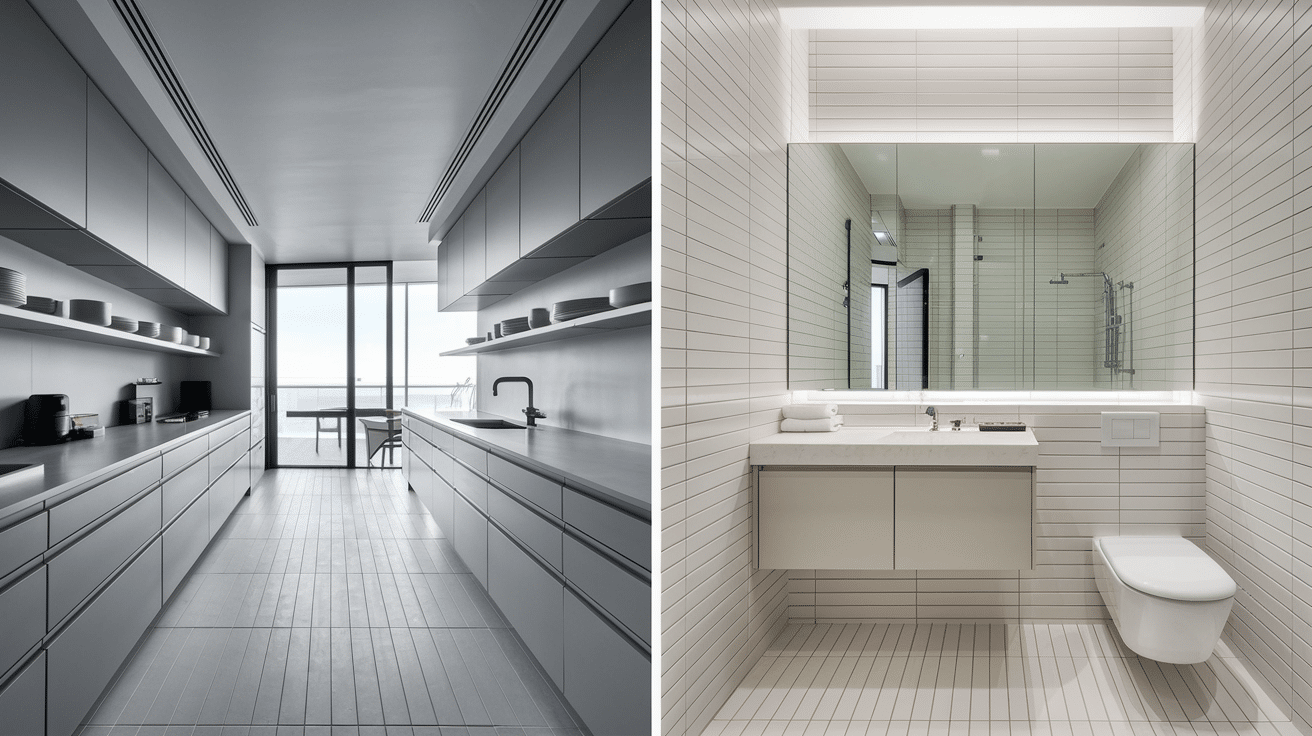
Kitchens and bathrooms also benefit from horizontal lines. Long cabinets, drawers, and open shelves stretch across the walls. These features add order and help the rooms feel neat.
In kitchens, cabinet handles and tile backsplashes can add even more lines. When lined up well, these small details make the space feel wider, and the layout becomes easier to follow.
Floating vanities and horizontal tile patterns work the same way in bathrooms. They help open up smaller rooms, and they offer both function and a clean look.
Stick with lines that match the size of the room. Thinner shelves or tiles work better in smaller spaces. Keep the design simple and easy to maintain.
Design Elements That Introduce Horizontal Lines
You don’t need a full remodel to bring horizontal lines into your home. Many common design features already include them. With the right choices, you can add lines that help shape the room and keep things feeling balanced.
1. Wall Paneling and Trim Work
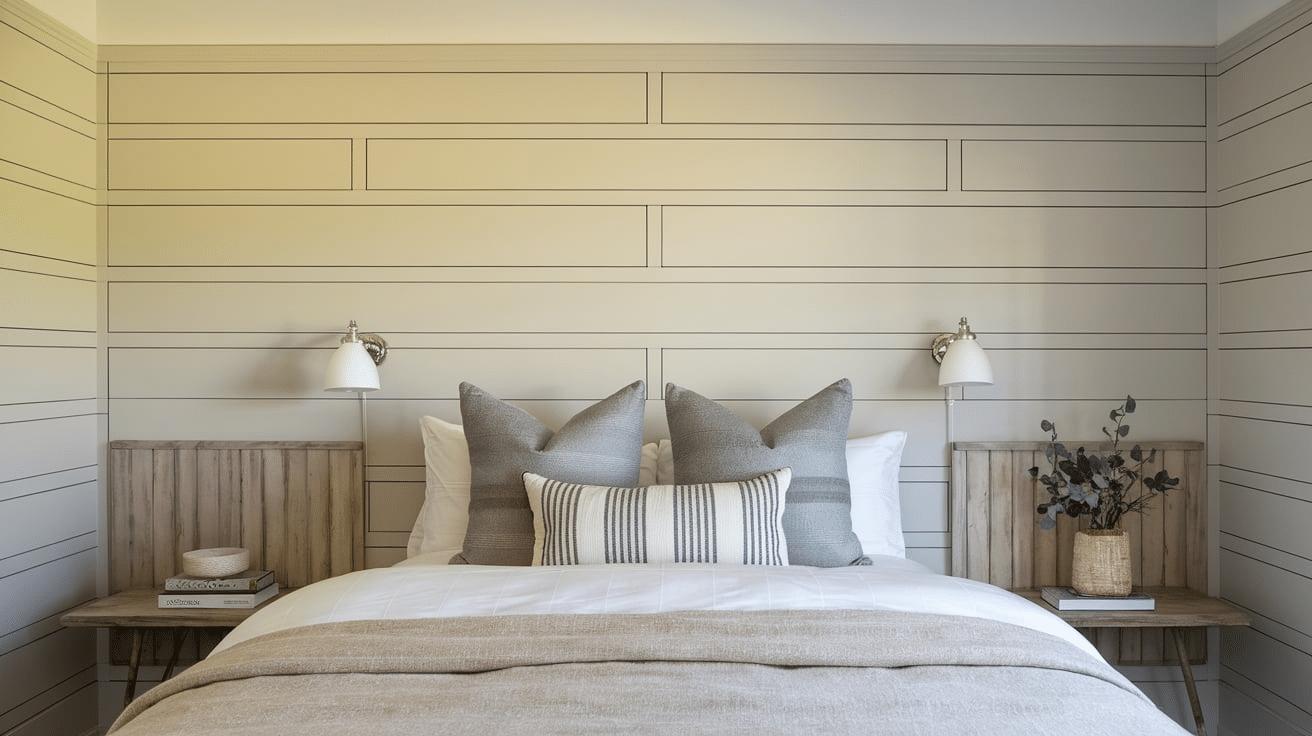
Wall paneling is a simple way to add horizontal lines to any room. Shiplap, beadboard, or even long trim boards create lines that stretch across the wall. These lines help a room feel wider and more pulled together.
Paneling works well in entryways, bathrooms, or behind beds. It adds texture and structure, and the horizontal layout brings a calm and even look.
You can paint the paneling to match your wall or use a slightly different shade. This keeps it simple and easy on the eyes. The effect still works, even when colors are soft.
Trim boards can also be placed lower on the wall. This anchors the space and draws attention to the room’s base, helping set the tone for everything above.
2. Low, Wide Furniture Pieces
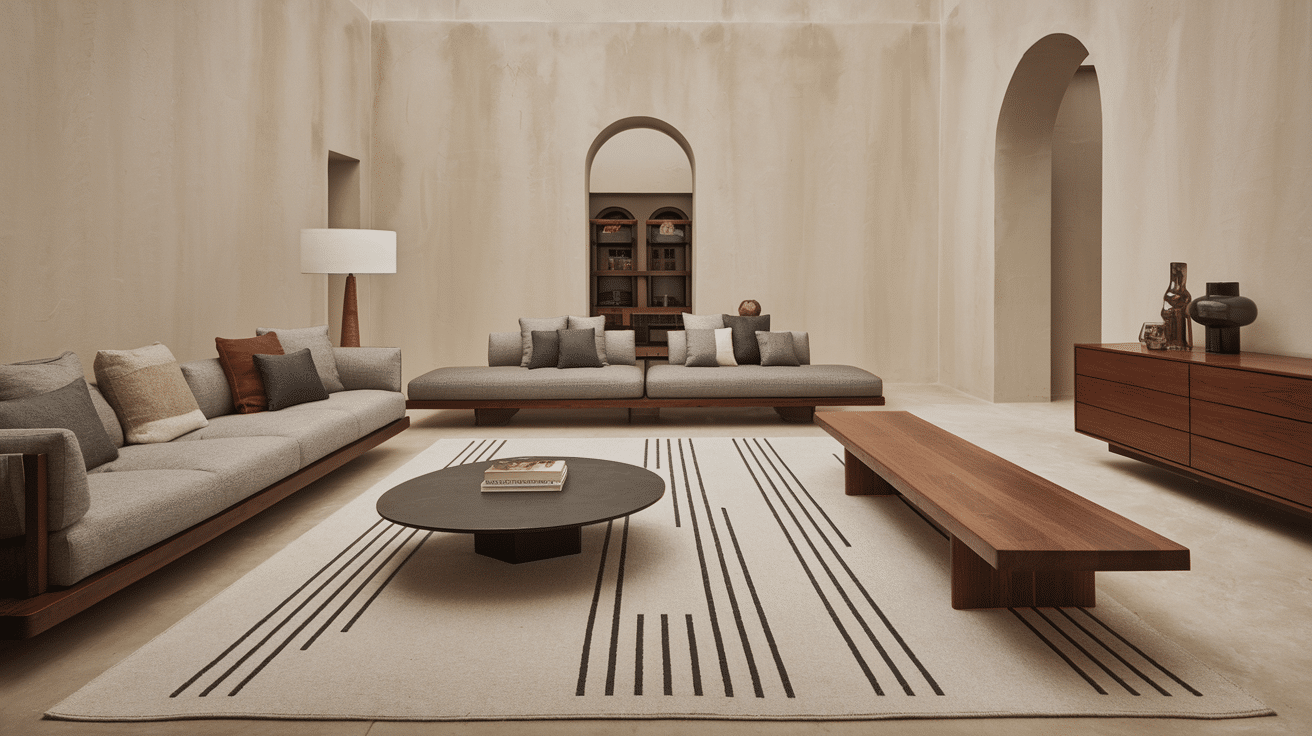
Furniture is one of the easiest ways to add horizontal lines. Pieces like long sofas, low dressers, and wide benches naturally create this look. They ground the room and add flow from one side to the other.
These shapes work well in large and small rooms. In smaller spaces, they help the room feel longer. In larger ones, they help fill space without making it feel crowded.
You don’t need a lot of furniture to get the effect. One or two well-placed pieces are enough. Keep the shapes clean and simple.
Pair these items with a rug that also has horizontal lines or shapes. This helps pull the room together even more, and everything starts to feel connected.
3. Horizontal Patterns in Wallpaper and Curtains
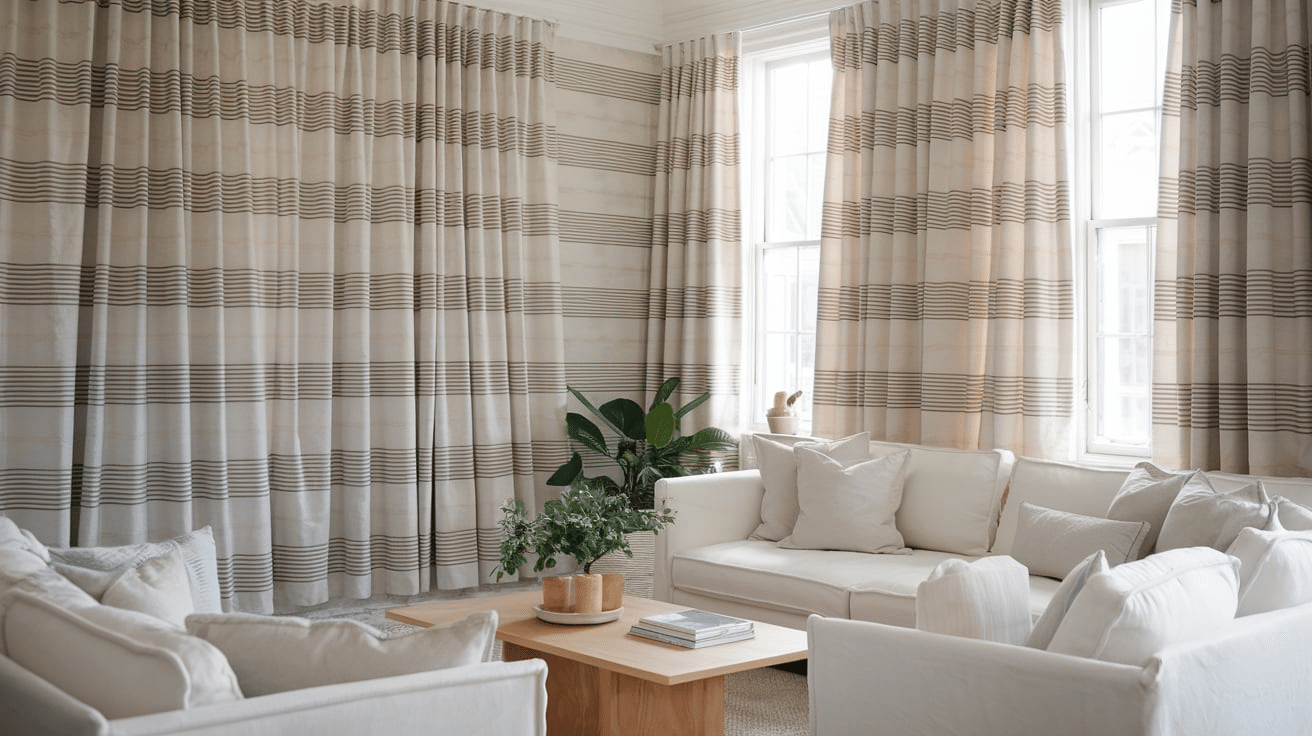
Patterns can softly, low-effortly add horizontal lines. Wallpapers with horizontal stripes or wide bands bring this effect to the wall, and curtains with wide stripes or rows of designs do the same.
These features guide the eyes from side to side, helping the room feel stretched out and calm. It’s a nice way to shape the space’s mood.
Keep the pattern soft if you want a relaxed feel. Thin lines or soft tones work best in bedrooms or sitting areas, while bolder stripes can go in playrooms or kitchens.
Too many patterns can feel busy. Stick to one feature—either the wall or the curtains. This keeps the lines helpful, not distracting.
4. Floating Shelves and Light Fixtures
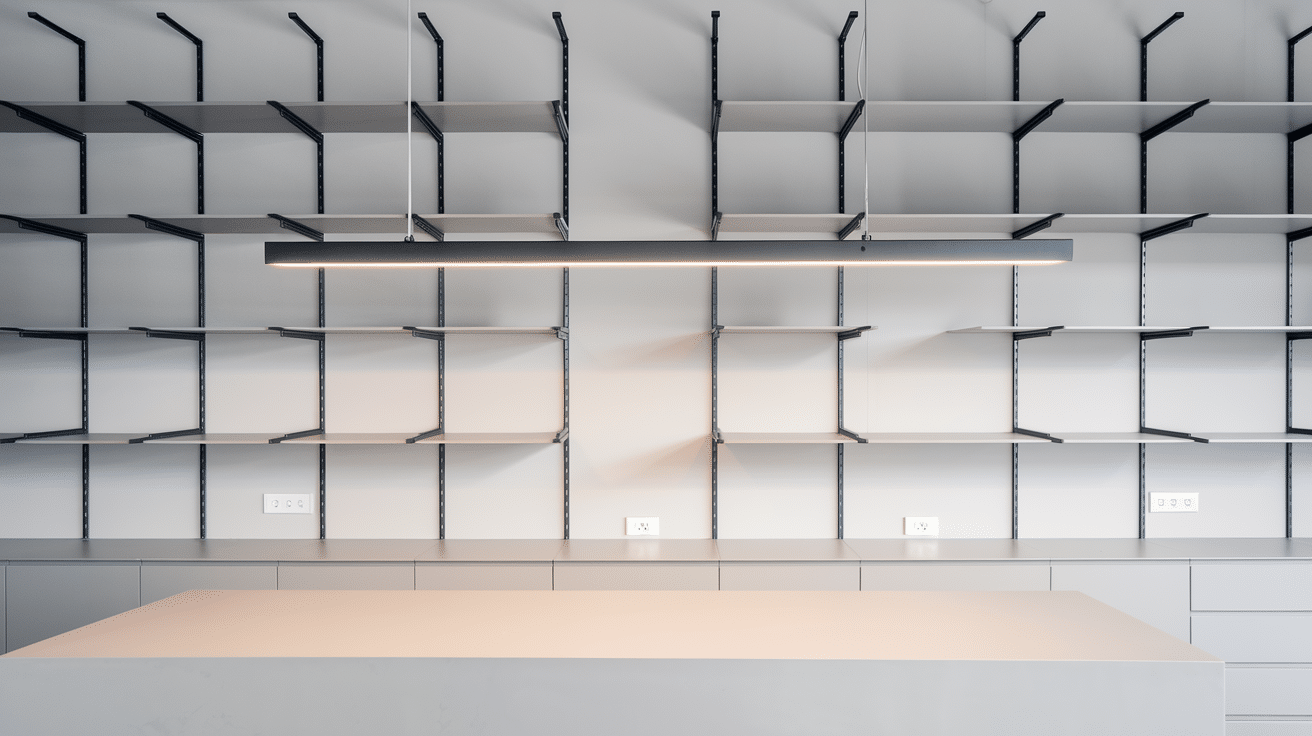
Floating shelves are a stylish and useful way to add horizontal lines. They stretch across the wall while giving you space to store or display items. Their simple shape keeps the room feeling open.
You can place them in living rooms, kitchens, or even hallways. Just one or two shelves are enough to guide the eye and shape the space. Keep them spaced evenly for the best effect.
Light fixtures can also add horizontal lines, especially long, thin designs. A bar-style pendant or wall-mounted light brings both light and form. They fit well in dining areas or over kitchen islands.
These small items can have a big impact. They help the room feel planned without feeling full. Simple lines do more than you might expect.
How to Balance Horizontal Lines with Other Types
Horizontal lines can bring a lot of calm and structure to a room, but they work best when paired with other types of lines. If you use only horizontal lines, the space can start to feel flat or stretched. Mixing in other shapes and directions helps the room feel more complete and balanced.
Vertical lines are a good match for horizontal ones. They move the eye upward, adding a sense of height and strength. Tall bookcases, door frames, and long curtains are easy ways to include them.
Curved lines can also help break up too many straight edges. They bring softness and make the room feel more relaxed. You can add them through round mirrors, chairs, or soft archways.
The key is not to use too many line styles at once. Choose one main direction and add the others in small amounts. This keeps the space clear, open, and easy to enjoy.
It’s also helpful to think about how the room will be used. If it’s a space for rest, use more horizontal lines. If it’s for focus or movement, add vertical or curved lines where they make sense.
Benefits of Using Horizontal Lines Thoughtfully
Horizontal lines can do more than change how a room looks—they can also shape how it feels. When used the right way, they help create a space that feels calm, open, and well-planned. They’re simple to apply and can work in almost any type of room.
- Peaceful: Horizontal lines make a room feel calm by adding a sense of rest and stillness.
- Organized: Horizontal lines help guide the eye across a space, creating a clean and structured look.
- Spacious: Horizontal lines can make narrow rooms appear wider and more open.
- Subtle: Horizontal lines add style in a quiet way without using bold colors or strong patterns.
When used with care, horizontal lines offer both beauty and function. They can shape a space without requiring many changes, and even small touches can help bring a sense of balance and comfort to a room.
Mistakes to Avoid with Horizontal Lines
While horizontal lines can improve a room, using them the wrong way can have the opposite effect. It’s important to know what to avoid to keep the space balanced and visually clear.
- Overused: Using too many horizontal lines can make the space feel flat and dull instead of calm.
- Unbalanced: Ignoring vertical or curved lines can make the design feel too one-sided.
- Cluttered: Mixing too many patterns with horizontal lines can confuse the overall look.
- Misplaced: Putting horizontal lines at the wrong height can affect how the room feels and flows.
By avoiding these mistakes, you can fully benefit from horizontal lines. Think about how each line supports the space and the mood you want to create. A well-balanced design will always feel more welcoming and easy to enjoy.
Conclusion
Horizontal lines are a smart way to shape a room’s look and feel. They make spaces feel calm, wide, and steady. From wall trim to long furniture, these lines can help guide the eye and create a sense of order.
To get the best results, it’s important to use them with care. Balance them with vertical or curved lines to keep the room from feeling too flat. Look for ways to blend style with comfort by using clean lines that match the space.
You don’t need a full room makeover to try this. Small changes—like a shelf, bench, or striped pattern—can make a difference. Keep it simple and test one area at a time.
With a little thought and the right touches, horizontal lines can help you create rooms that feel more open and organized. Start with what you have and build from there.

